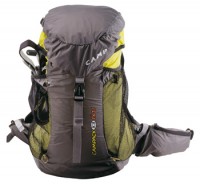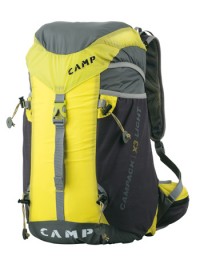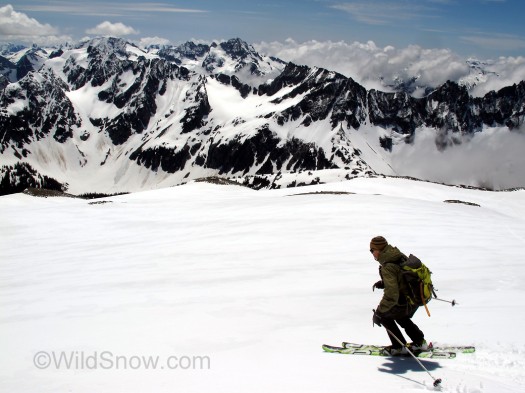Shop for CAMP ski touring backpacks.
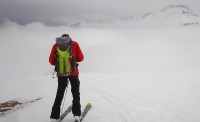
Lou with the CAMP X3-Light, head down and eyes on the GPS, self guided Europe, last spring. Click to enlarge.
We run a stable of backpacks here at WildSnow HQ that could outfit a small army. That’s no surprise considering the market battle that rucksack makers have fought for decades. Results: choices, reasonable prices — and the fog of war obscuring just what ruck’ to run. If you’re shopping and need to disolve the fog, consider dividing ski touring backpacks into two main categories:
“Bomber” is a good term for the type of pack that uses heavier materials, thus sacrificing weight for durability. Such packs are common in the North American market; easily spotted in the shop or online by their somewhat heavier weight as well as a sometimes odd looking effort to appear “clean.” They usually lack things such as waist belt pockets and mesh side pockets, and are frequently zippered panel loaders. Bomber category packs often include multiple zippered compartments, sometimes to the point of absurdity.
Bomber category packs have their place. But if you don’t really need one, why haul the extra weight?
Euro-light would be the “Euro” style rucksack that obviously sacrifices durability for a sometimes astounding lack of mass. Along with using lighter textiles, such packs frequently lack internal dividers, thus saving more grams. Conversely, the Euro-light rucksack frequently has more “technical” features than the bomber, diagonal ski carry hooks being one example. Euro-light packs are often 10 or more ounces lighter than those in the bomber category.
We have packs from both categories, but I’ll be the first to admit I’m mostly a Euro-light packer. That works for me because, though I’m out lots of days every season, I’m not throwing my pack down in scree or using it for Cascadian devil’s club farming. More, I’ve made a science out of carrying just the essentials, and a rather lean set of essentials at that (not going so far as the European “shovel and a handy” style of packing, but keeping that ethos in mind). So the weight I’m expecting my pack to handle is minimal.
One huge caveat: In the Euro-light category, construction practices have to exceed the engineering expertise used to create bomber category backpacks, due to a matrix of materials that tend to fail at their weak links. The reality of this struck last winter, when I embarked on one lightweight backpack review only to have seams ripping out after a few hours of use. In other words, a Euro-light backpack that holds together takes a lot more skill to design and make than a heavy packcloth type design.
Happily, the CAMP rucksacks we long-term tested last winter (and even this summer for hiking) held up amazingly well considering their almost tissue-paper like materials. Truly high level textile construction engineeering. Hence, here goes a review of our two CAMP favorites.
X3 600 is the pack Lisa and I could be fighting over, but in my beneficent glory I let my bride have it for the winter. This 30 liter masterpiece gives what nearly any ski alpinist needs, but nothing more. The only zipper is in the top flap. One simple fiberglas stay runs up the back to help keep the pack carrying correctly when you’re weighed down with rope and skis. Remove the stay, 8 seconds, and you’re 40 grams lighter. Ski carrying is diagonal with dedicated tail loop and upper strap/hook that hides away nicely in a tiny mesh pocket. This type of ski holder takes some getting used to, but it works. Don’t like it? Just add a carabiner or whatever to your own specifications.
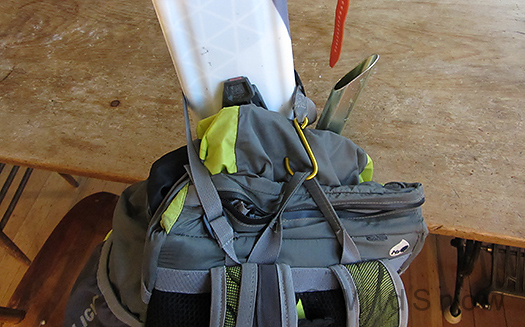
CAMP diagonal ski carry is anchored at the top by this strap and hook. Normally I find this to be totally adaquate, but sometimes I'd rather have a small carabiner holding things instead of a hook that can come off if the skis start shaking around. Such is critical when you find yourself in situations such a as scrambling a summit climb with fall potential. I your skis come off the pack when unexpected, they can cause you to trip and fall.
The X3 600 waist belt pouch is commodious, but not so large it hits your thigh while you stride. Exterior side pouches are tall enough to securely hold anything from a water bottle to your climbing skins (many packs have exterior pockets that are too short). Speaking of the mesh, we prefer closed mesh such as that of the X3-Light, as the open mesh tends to catch too easily on tree branches and other people’s gear — but open mesh is light and you can see what’s in there.
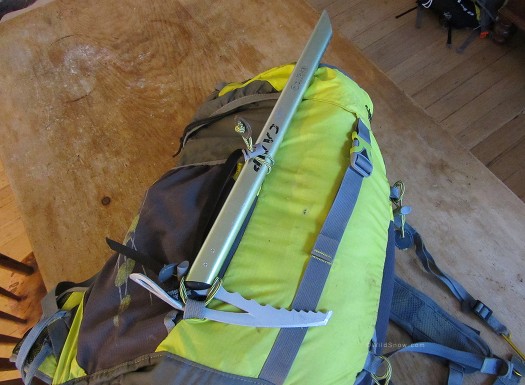
Alpine tools are attached using a minimalist system of bungie and drawstring clamps. While this system doesn't allow 'reach behind' access to your axe, when used correctly the attachment is secure.
Provision is made for a pair of minimalist lashing points for alpine tools or trekking poles. Consisting of a tiny double wrapped bungie and drawstring clamp, these work better than they look, though you may yearn for “real” tool holders if you tend to put your ice axe through multiple use cycles.
Two small lashing tabs are provided under the top flap if you want to rig custom rope or garment stowage. One simple buckle holds the flap.
CAMP X3-Light (actually significantly heavier than X3 600) adds a somewhat more rigid aluminum frame that I liked for larger loads. The frame is easy to remove. A dual-zippered back panel gives you that convenient access when your pack is lying on the snow after shrugging it off. I’ve never felt a yearning need for that, but I’ll admit it’s sometimes nice. Main difference to me is the x3-Light external side pockets are made with a tighter mesh. You can’t see that errant GU pack down in the bottom of the pocket, but they don’t catch on things like open mesh does.
While X3-Light and 600 are essentially the same shape and volume, their respective waist belts and shoulder straps are constructed differently. In testing, that meant they looked different but felt the same, so no need for scientific exposition on that.
There you go. How to decide between the two? If ultra weight savings are your thing look no farther than the X3 600. If you like back panel access and a slightly more rigid frame, shop the X3-Light (which is harder to find). Don’t expect ultra durability from these sacks, but do enjoy significant weight savings over “bomber” category offerings.
Last word in terms of durability: After quite a bit of use, we didn’t see any poorly engineered failure points in these sacks; the only damage was to the lightweight fabric itself from things like abrasion from poorly lashed skis (hint, stick a hat or something between ski bindings and pack). Oh, and one more thing, don’t expect major water resistance from Euro-light rucksacks. People who use them duck into huts when it’s raining, or watch ski racing at a pub.
Weights (both packs about 30 liters capacity):
X3 600 is 21.8 ounces, 1616 grams.
X3-Light is 30.6 ounces, 870 grams (typical, call the heavier pack “light,” don’t you love it?)
Shop for CAMP ski touring backpacks.
WildSnow.com publisher emeritus and founder Lou (Louis Dawson) has a 50+ years career in climbing, backcountry skiing and ski mountaineering. He was the first person in history to ski down all 54 Colorado 14,000-foot peaks, has authored numerous books about about backcountry skiing, and has skied from the summit of Denali in Alaska, North America’s highest mountain.

